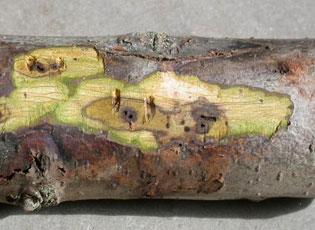Geosmithia morbida (Kolařík et al. 2011)
Thousand cankers black walnut disease (TCD)
Disease was first detected in the Western U.S.; the disease vector, the walnut twig beetle, is native to the southwestern U.S. and Mexico (Utley et al. 2013)
First observed in the 1990s, but not recognized until 2008 (Utley et al. 2013)
Unknown, but possibly through the transportation of logs and firewood (Randolph et al. 2013)
Fungal disease of walnut trees (Juglans spp.), particularly the black walnut (Juglans nigra), that is usually lethal within a few years; disease is transmitted by the walnut twig beetle, Pityophthorus juglandis (Tisserat et al. 2009)
Widespread throughout the Western U.S.; first detected in the Eastern U.S. in Aug 2010

Thousand Cankers Disease
Walnut twig galleries and cankers in branch of hybrid walnut; associated with walnut trig beetle Ned Tisserat, Colorado State University
Distribution / Maps / Survey Status
Videos
Selected Resources
The section below contains highly relevant resources for this species, organized by source.
Partnership
Federal Government
State and Local Government
Academic
Kolařík, M., E. Freeland, C. Utley, and N. Tisserat. 2011. Geosmithia morbida sp. nov., a new phytopathogenic species living in symbiosis with the walnut twig beetle (Pityophthorus juglandis) on Juglans in USA. Mycologia 103(2):325-332.
Randolph, K.C., A.K. Rose, C.M. Oswalt, and M.J. Brown. 2013. Status of black walnut (Juglans nigra L.) in the eastern United States in light of the discovery of thousand cankers disease. Castanea 78(1):2-14.
Tisserat, N., W. Cranshaw, D. Leatherman, C. Utley, and K. Alexander. 2009. Black walnut mortality in Colorado caused by the walnut twig beetle and thousand cankers disease. Plant Health Progress.
Utley, C., T. Nguyen, T. Roubtsova, M. Coggeshall, T.M. Ford, L.J. Grauke, A.D. Graves, C.A. Leslie, J. McKenna, K. Woeste, M.A. Yaghmour, W. Cranshaw, S.J. Seybold, R.M. Bostock, and N. Tisserat. 2013. Susceptibility of walnut and hickory species to Geosmithia morbida. Plant Disease 97(5):601-607.
